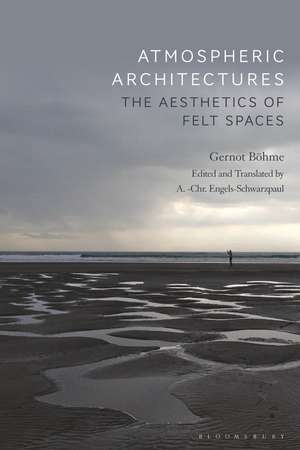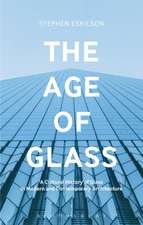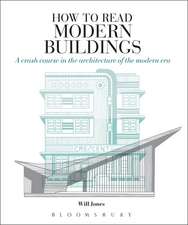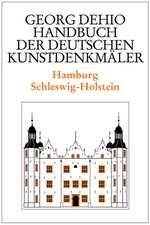Atmospheric Architectures: The Aesthetics of Felt Spaces
Autor Professor Gernot Böhme Editat de Professor Tina Engels-Schwarzpaulen Limba Engleză Paperback – 5 feb 2020
| Toate formatele și edițiile | Preț | Express |
|---|---|---|
| Paperback (1) | 187.70 lei 3-5 săpt. | +72.93 lei 7-13 zile |
| Bloomsbury Publishing – 5 feb 2020 | 187.70 lei 3-5 săpt. | +72.93 lei 7-13 zile |
| Hardback (1) | 539.57 lei 6-8 săpt. | |
| Bloomsbury Publishing – 2 mai 2018 | 539.57 lei 6-8 săpt. |
Preț: 187.70 lei
Preț vechi: 242.35 lei
-23% Nou
Puncte Express: 282
Preț estimativ în valută:
35.92€ • 37.60$ • 29.72£
35.92€ • 37.60$ • 29.72£
Carte disponibilă
Livrare economică 15-29 martie
Livrare express 01-07 martie pentru 82.92 lei
Preluare comenzi: 021 569.72.76
Specificații
ISBN-13: 9781350141827
ISBN-10: 1350141828
Pagini: 216
Ilustrații: 30 bw illus
Dimensiuni: 156 x 234 x 16 mm
Greutate: 0.48 kg
Editura: Bloomsbury Publishing
Colecția Bloomsbury Visual Arts
Locul publicării:London, United Kingdom
ISBN-10: 1350141828
Pagini: 216
Ilustrații: 30 bw illus
Dimensiuni: 156 x 234 x 16 mm
Greutate: 0.48 kg
Editura: Bloomsbury Publishing
Colecția Bloomsbury Visual Arts
Locul publicării:London, United Kingdom
Caracteristici
Böhme works within the framework of 'German New Phenomenology' - and as such this volume will be of interest to scholars of continental philosophy and aesthetics as well as to visual arts fields
Notă biografică
Gernot Böhme is Emeritus Professor of Philosophy at Darmstadt Technical University, Germany, and founder and director of the Institute for Practical Philosophy in Darmstadt.A.-Chr. Engels-Schwarzpaul (editor and translator) is Professor in Spatial Design and Postgraduate Studies at Auckland University of Technology - Te Wananga Aronui o Tamaki Makau Rau, in Auckland, Aotearoa/New Zealand.
Cuprins
Foreword: 'Ecstasies' by Professor Mark Dorrian (University of Edinburgh)Towards the Inside of Atmospheres: Translator's IntroductionAtmosphere, a basic concept of a new aestheticNew AestheticsBenjamin's auraThe concept of atmosphere in Hermann Schmitz' philosophyThe ecstasies of thingsMaking atmospheresThe critical potential of an aesthetics of atmospheresConclusionThe Ecstasies of Things: Ontology and aesthetics of thingnessSubjectivism in aestheticsTerminological differentiationsThe prevalence of the thing in ontologyLife within the world of thingsThe closure of the thing within the main ontological modelsAlternative thing modelsThe ThingConclusion: Ontology and aestheticsMaterial Splendour: A Contribution to the Critique of Aesthetic EconomyA golden ladleMaterial aestheticsMaterial beautyParticle boardInternal design and invisible aestheticsContribution to the critique of aesthetic economyAtmospheres in ArchitectureWeather and feelingsArchitecture and felt spaceAtmospheres as the subject matter of architectureThe perception of architectureArchitecture and spaceThe atmosphere of a cityConclusionThe Presence of Living Bodies in SpaceDevelopments in architecture and art historyWhat is the space of bodily presence?DispositionActuality and realityAtmospheres of Human CommunicationThe utterly familiarRadianceActualisation and disturbance of interpersonal atmospheresContributionsLearning to Live with Atmospheres: A new Aesthetic Humanist EducationObjectives of aesthetic educationSchiller's On the aesthetic education of man in a series of lettersAesthetic humanist education under the conditions of technical civilisation and aesthetic economyAtmosphere as the object and medium of aesthetic educationThe Grand Concert of the WorldIntroductionModern art and the aesthetics of atmospheresThe aesthetic conquest of acoustic spaceMusic and soundscape, or the music of the soundscapeAcoustic atmospheresConclusionThe Voice in Spaces of Bodily PresenceSpatial soundsThe rehabilitation of the voiceThe voice as an articulation of bodily presenceConclusionLight and SpaceThe phenomenology of light Cleared spaceThe space of lightLights in spaceThings appearing in lightLight on thingsLightingThe Art of Staging as a Paradigm for an Aesthetics of AtmospheresProducing atmospheresAtmosphere - a well-known but extremely vague phenomenonAesthetics of reception and productionFantastic art/unreliable fabricationConclusion: the art of stagingChurch AtmospheresThe numinous and the profanization of church spacesSacred twilight - diaphanous lightSilence and the SublimeStone and spaceGenius LociAfterword: 'Atmospheres to Think About' by Professor David Leatherbarrow (University of Pennsylvania) ReferencesIndex
Recenzii
A fascinating collection of essays by the German philosopher Gernot Böhme . . . the essays are thoughtfully translated, and usefully introduced, in a way that will make Bohme's work accessible and engaging to a wide audience. The message of the book is inspirational in its shift from the study of objects toward experience, and it will sit nicely among similarly motivated titles in Bloomsbury Academic's impressively burgeoning architecture library.













